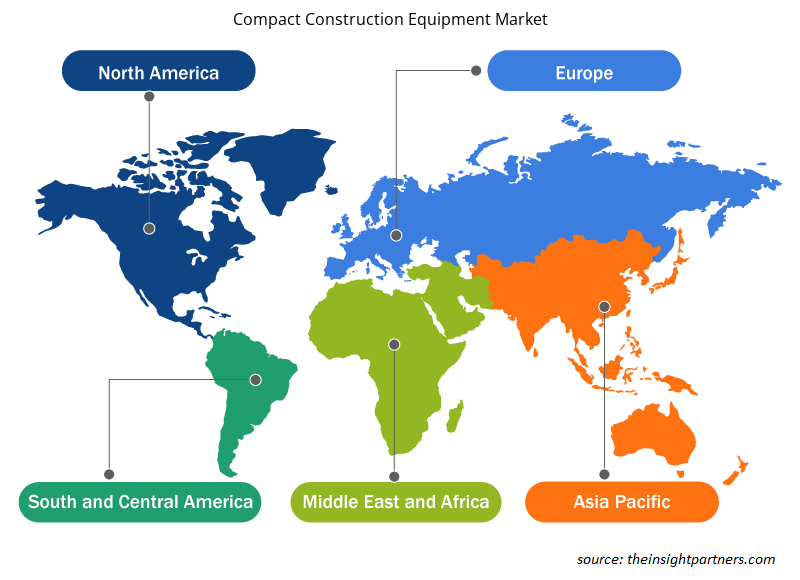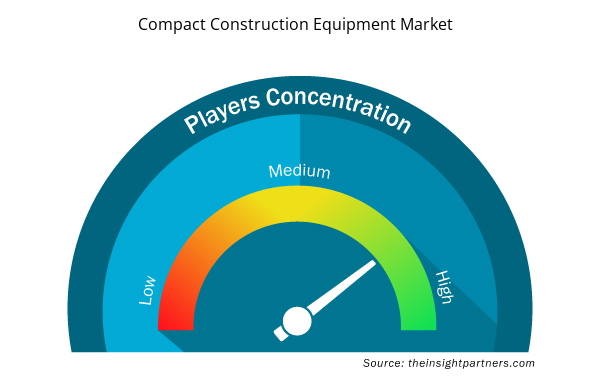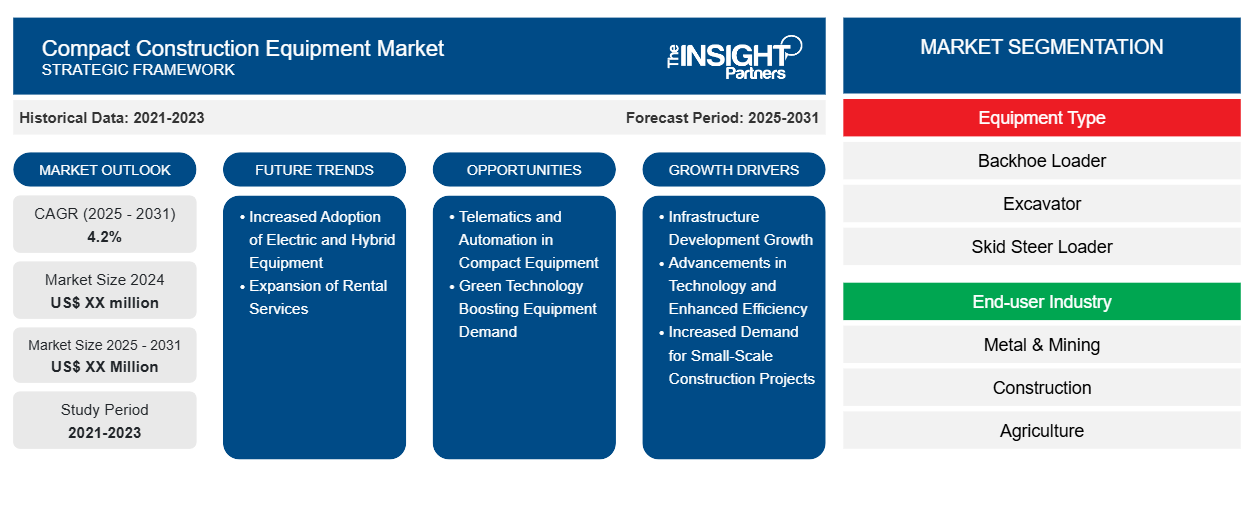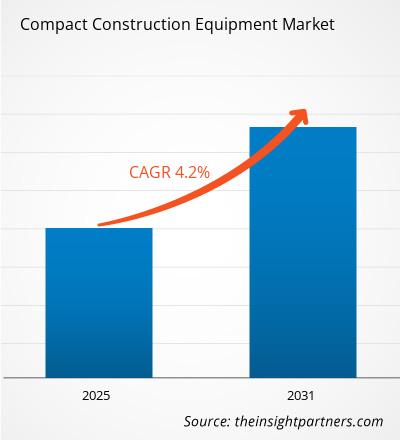Si prevede che il mercato delle attrezzature compatte per l'edilizia registrerà un CAGR del 4,2% dal 2023 al 2031, con una dimensione di mercato in espansione da XX milioni di dollari nel 2023 a XX milioni di dollari entro il 2031.
Il mercato è suddiviso in Attrezzatura, Utente finale e Applicazione. Il segmento Attrezzatura è suddiviso in Terna, Escavatore, Minipala, Sollevatore telescopico, Caricatore cingolato e Altri. In base all'Utente finale, il mercato è suddiviso in Metalli e minerario, Edilizia, Agricoltura e Altri. In base all'Applicazione, il mercato è suddiviso in Caricamento, Scavo, Movimentazione materiali, Sollevamento e sollevamento e Altri
Scopo del rapporto
Il report Compact Construction Equipment Market di The Insight Partners mira a descrivere il panorama attuale e la crescita futura, i principali fattori trainanti, le sfide e le opportunità. Ciò fornirà spunti a vari stakeholder aziendali, come:
- Fornitori/produttori di tecnologia: per comprendere le dinamiche di mercato in evoluzione e conoscere le potenziali opportunità di crescita, consentendo loro di prendere decisioni strategiche informate.
- Investitori: condurre un'analisi completa delle tendenze in merito al tasso di crescita del mercato, alle proiezioni finanziarie del mercato e alle opportunità esistenti lungo la catena del valore.
- Enti di regolamentazione: regolamentano le politiche e le attività di controllo sul mercato allo scopo di ridurre al minimo gli abusi, preservare la fiducia degli investitori e sostenere l'integrità e la stabilità del mercato.
Segmentazione del mercato delle attrezzature da costruzione compatte
Tipo di apparecchiatura
- Terna-caricatrice
- Escavatore
- Caricatore Skid Steer
- Sollevatore telescopico
- Caricatore cingolato
- Altri
Industria dell'utente finale
- Metalli e estrazione mineraria
- Costruzione
- Agricoltura
- Altri
Applicazione
- Caricamento
- Scavo
- Movimentazione dei materiali
- Sollevamento e sollevamento
- Altri
Geografia
- America del Nord
- Europa
- Asia-Pacifico
- America del Sud e Centro
- Medio Oriente e Africa
Geografia
- America del Nord
- Europa
- Asia-Pacifico
- America del Sud e Centro
- Medio Oriente e Africa
Personalizza questo report in base alle tue esigenze
Riceverai la personalizzazione gratuita di qualsiasi report, comprese parti di questo report, o analisi a livello nazionale, pacchetto dati Excel, oltre a usufruire di grandi offerte e sconti per start-up e università
- Scopri le principali tendenze di mercato in questo rapporto.Questo campione GRATUITO includerà analisi di dati che spaziano dalle tendenze di mercato alle stime e alle previsioni.
Fattori trainanti della crescita del mercato delle attrezzature compatte per l'edilizia
- Crescita dello sviluppo delle infrastrutture: un aumento dei livelli di investimento nei progetti infrastrutturali in tutto il mondo è diventato uno dei principali motori del mercato delle attrezzature edili compatte. I governi e i settori privati stanno investendo massicciamente nella costruzione di strade, ponti e sviluppi urbani, il che aumenta la domanda di macchinari compatti che possono funzionare in spazi limitati in grandi numeri.
- Progressi nella tecnologia e maggiore efficienza: il miglioramento tecnologico delle attrezzature edili compatte, tra cui l'efficienza del carburante, i miglioramenti delle prestazioni e l'integrazione telematica, alimenta la crescita del mercato. Tali innovazioni aiutano anche a ridurre i costi operativi migliorando la produttività e gestendo meglio le attrezzature; pertanto, le macchine edili compatte rimangono altamente attraenti sia per gli appaltatori che per le società di noleggio.
- Domanda crescente di progetti di costruzione su piccola scala: questo tipo di attrezzatura è in aumento a causa dell'aumento di progetti di costruzione su piccola scala come infrastrutture residenziali, di giardinaggio e di governo locale. Questo perché le attrezzature da costruzione compatte sono altamente produttive ma meno esigenti in termini di spazio operativo e di un numero inferiore di lavoratori. Possono gestire varie operazioni come scavo, livellamento e sollevamento, tra le altre.
Tendenze future del mercato delle attrezzature da costruzione compatte
- Maggiore adozione di attrezzature elettriche e ibride: l'introduzione di attrezzature edili compatte elettriche e ibride è diventata notevolmente in voga. Questo perché tali macchine producono sostanziali riduzioni delle emissioni e tagli significativi nei costi operativi per gli utenti, oltre alle pressioni normative per diventare ecologici che crescono sempre di più nel regno delle costruzioni.
- Espansione dei servizi di noleggio: la tendenza a noleggiare anziché acquistare attrezzature edili sta prendendo piede. La maggior parte degli appaltatori preferisce noleggiare attrezzature edili compatte per evitare spese in conto capitale e ridurre la manutenzione delle attrezzature, richiedendo quindi un mercato del noleggio più ampio per supportare questa domanda di macchinari compatti.
Opportunità di mercato per le attrezzature edili compatte
- Telematica e automazione in attrezzature compatte: Telematica e automazione, tra le altre tecnologie avanzate, aprono una grande porta per le attrezzature edili compatte. La telematica può contribuire in modo significativo a promuovere l'efficienza operativa, migliorare la sicurezza e analizzare i dati in tempo reale, rendendo tali attrezzature compatte ancora più attraenti per appaltatori e aziende edili.
- La tecnologia verde aumenta la domanda di attrezzature: con una maggiore enfasi sulla sostenibilità da parte del settore edile, le attrezzature edili compatte che integrano la tecnologia verde sono destinate a trovare più opportunità. Le attrezzature a basse emissioni e a basso consumo di carburante possono attrarre il cliente attento all'ambiente e saranno più in sintonia con i requisiti normativi più severi
Approfondimenti regionali sul mercato delle attrezzature per l'edilizia compatta
Le tendenze regionali e i fattori che influenzano il mercato delle attrezzature per costruzioni compatte durante il periodo di previsione sono stati ampiamente spiegati dagli analisti di Insight Partners. Questa sezione discute anche i segmenti e la geografia del mercato delle attrezzature per costruzioni compatte in Nord America, Europa, Asia Pacifico, Medio Oriente e Africa e America meridionale e centrale.

- Ottieni i dati specifici regionali per il mercato delle attrezzature per costruzioni compatte
Ambito del rapporto di mercato sulle attrezzature per costruzioni compatte
| Attributo del report | Dettagli |
|---|---|
| Dimensioni del mercato nel 2023 | XX milioni di dollari USA |
| Dimensioni del mercato entro il 2031 | XX milioni di dollari USA |
| CAGR globale (2023-2031) | 4,2% |
| Dati storici | 2021-2022 |
| Periodo di previsione | 2024-2031 |
| Segmenti coperti | Per tipo di apparecchiatura
|
| Regioni e Paesi coperti | America del Nord
|
| Leader di mercato e profili aziendali chiave |
|
Densità degli operatori del mercato delle attrezzature per l'edilizia compatta: comprendere il suo impatto sulle dinamiche aziendali
Il mercato delle attrezzature per l'edilizia compatta sta crescendo rapidamente, spinto dalla crescente domanda degli utenti finali dovuta a fattori quali l'evoluzione delle preferenze dei consumatori, i progressi tecnologici e una maggiore consapevolezza dei vantaggi del prodotto. Con l'aumento della domanda, le aziende stanno ampliando le loro offerte, innovando per soddisfare le esigenze dei consumatori e capitalizzando sulle tendenze emergenti, il che alimenta ulteriormente la crescita del mercato.
La densità degli operatori di mercato si riferisce alla distribuzione di aziende o società che operano in un particolare mercato o settore. Indica quanti concorrenti (operatori di mercato) sono presenti in un dato spazio di mercato in relazione alle sue dimensioni o al valore di mercato totale.
Le principali aziende che operano nel mercato delle attrezzature compatte per l'edilizia sono:
- Caterpillar, Inc.
- AB Volvo
- Deere & Società
- Hyundai Heavy Industries Co. Ltd
- Gruppo XCMG
Disclaimer : le aziende elencate sopra non sono classificate secondo un ordine particolare.

- Ottieni una panoramica dei principali attori del mercato delle attrezzature da costruzione compatte
Punti di forza chiave
- Copertura completa: il rapporto esamina in modo completo i prodotti, i servizi, le tipologie e gli utenti finali del mercato delle attrezzature compatte per l'edilizia, offrendo una panoramica olistica.
- Analisi degli esperti: il rapporto è compilato sulla base della conoscenza approfondita di esperti e analisti del settore.
- Informazioni aggiornate: il rapporto garantisce la pertinenza aziendale grazie alla copertura di informazioni recenti e tendenze nei dati.
- Opzioni di personalizzazione: questo report può essere personalizzato per soddisfare le esigenze specifiche del cliente e adattarsi in modo appropriato alle strategie aziendali.
Il rapporto di ricerca sul Compact Construction Equipment Market può, quindi, aiutare a guidare il percorso di decodifica e comprensione dello scenario del settore e delle prospettive di crescita. Sebbene possano esserci alcune preoccupazioni valide, i vantaggi complessivi di questo rapporto tendono a superare gli svantaggi.
- Analisi storica (2 anni), anno base, previsione (7 anni) con CAGR
- Analisi PEST e SWOT
- Valore/volume delle dimensioni del mercato - Globale, regionale, nazionale
- Industria e panorama competitivo
- Set di dati Excel



Report Coverage
Revenue forecast, Company Analysis, Industry landscape, Growth factors, and Trends

Segment Covered
This text is related
to segments covered.

Regional Scope
North America, Europe, Asia Pacific, Middle East & Africa, South & Central America

Country Scope
This text is related
to country scope.
Domande frequenti
The leading players includes Caterpillar, Inc., AB Volvo, Deere & Company, Hyundai Heavy Industries Co. Ltd, XCMG Group, J C Bamford Excavators Ltd., Komatsu Ltd, Manitou BF, Hyster-Yale Group, Inc.., and Sany Group
The report can be delivered in PDF/PPT format; we can also share excel dataset based on the request.
Some of the customization options available based on the request are an additional 3-5 company profiles and country-specific analysis of 3-5 countries of your choice. Customizations are to be requested/discussed before making final order confirmation, as our team would review the same and check the feasibility.
The Compact Construction Equipment Market Size and Forecasts (2021 - 2031), Global and Regional Share, Trends, and Growth Opportunity Analysis Report Coverage:by Equipment Type (Backhoe Loader, Excavator, Skid Steer Loader, Telehandler, Track Loader, and Others), End-user Industry (Metal & Mining, Construction, Agriculture, and Others), and Application (Loading, Excavation, Material Handling, Lifting & Hoisting, and Others), and Geography (North America, Europe, Asia Pacific, and South and Central America) is estimated to witness a CAGR of 4.2% from 2023 to 2031
The major factors driving the Compact Construction Equipment market are: Infrastructure Development Growth
Trends and growth analysis reports related to Manufacturing and Construction : READ MORE..
1. Caterpillar, Inc.
2. AB Volvo
3. Deere & Company
4. Hyundai Heavy Industries Co. Ltd
5. XCMG Group
6. J C Bamford Excavators Ltd.
7. King Machinery
8. Komatsu,.Ltd
9. Manitou BF, S.A. (Mustang)
10. SANY Group
The Insight Partners performs research in 4 major stages: Data Collection & Secondary Research, Primary Research, Data Analysis and Data Triangulation & Final Review.
- Data Collection and Secondary Research:
As a market research and consulting firm operating from a decade, we have published and advised several client across the globe. First step for any study will start with an assessment of currently available data and insights from existing reports. Further, historical and current market information is collected from Investor Presentations, Annual Reports, SEC Filings, etc., and other information related to company’s performance and market positioning are gathered from Paid Databases (Factiva, Hoovers, and Reuters) and various other publications available in public domain.
Several associations trade associates, technical forums, institutes, societies and organization are accessed to gain technical as well as market related insights through their publications such as research papers, blogs and press releases related to the studies are referred to get cues about the market. Further, white papers, journals, magazines, and other news articles published in last 3 years are scrutinized and analyzed to understand the current market trends.
- Primary Research:
The primarily interview analysis comprise of data obtained from industry participants interview and answers to survey questions gathered by in-house primary team.
For primary research, interviews are conducted with industry experts/CEOs/Marketing Managers/VPs/Subject Matter Experts from both demand and supply side to get a 360-degree view of the market. The primary team conducts several interviews based on the complexity of the markets to understand the various market trends and dynamics which makes research more credible and precise.
A typical research interview fulfils the following functions:
- Provides first-hand information on the market size, market trends, growth trends, competitive landscape, and outlook
- Validates and strengthens in-house secondary research findings
- Develops the analysis team’s expertise and market understanding
Primary research involves email interactions and telephone interviews for each market, category, segment, and sub-segment across geographies. The participants who typically take part in such a process include, but are not limited to:
- Industry participants: VPs, business development managers, market intelligence managers and national sales managers
- Outside experts: Valuation experts, research analysts and key opinion leaders specializing in the electronics and semiconductor industry.
Below is the breakup of our primary respondents by company, designation, and region:

Once we receive the confirmation from primary research sources or primary respondents, we finalize the base year market estimation and forecast the data as per the macroeconomic and microeconomic factors assessed during data collection.
- Data Analysis:
Once data is validated through both secondary as well as primary respondents, we finalize the market estimations by hypothesis formulation and factor analysis at regional and country level.
- Macro-Economic Factor Analysis:
We analyse macroeconomic indicators such the gross domestic product (GDP), increase in the demand for goods and services across industries, technological advancement, regional economic growth, governmental policies, the influence of COVID-19, PEST analysis, and other aspects. This analysis aids in setting benchmarks for various nations/regions and approximating market splits. Additionally, the general trend of the aforementioned components aid in determining the market's development possibilities.
- Country Level Data:
Various factors that are especially aligned to the country are taken into account to determine the market size for a certain area and country, including the presence of vendors, such as headquarters and offices, the country's GDP, demand patterns, and industry growth. To comprehend the market dynamics for the nation, a number of growth variables, inhibitors, application areas, and current market trends are researched. The aforementioned elements aid in determining the country's overall market's growth potential.
- Company Profile:
The “Table of Contents” is formulated by listing and analyzing more than 25 - 30 companies operating in the market ecosystem across geographies. However, we profile only 10 companies as a standard practice in our syndicate reports. These 10 companies comprise leading, emerging, and regional players. Nonetheless, our analysis is not restricted to the 10 listed companies, we also analyze other companies present in the market to develop a holistic view and understand the prevailing trends. The “Company Profiles” section in the report covers key facts, business description, products & services, financial information, SWOT analysis, and key developments. The financial information presented is extracted from the annual reports and official documents of the publicly listed companies. Upon collecting the information for the sections of respective companies, we verify them via various primary sources and then compile the data in respective company profiles. The company level information helps us in deriving the base number as well as in forecasting the market size.
- Developing Base Number:
Aggregation of sales statistics (2020-2022) and macro-economic factor, and other secondary and primary research insights are utilized to arrive at base number and related market shares for 2022. The data gaps are identified in this step and relevant market data is analyzed, collected from paid primary interviews or databases. On finalizing the base year market size, forecasts are developed on the basis of macro-economic, industry and market growth factors and company level analysis.
- Data Triangulation and Final Review:
The market findings and base year market size calculations are validated from supply as well as demand side. Demand side validations are based on macro-economic factor analysis and benchmarks for respective regions and countries. In case of supply side validations, revenues of major companies are estimated (in case not available) based on industry benchmark, approximate number of employees, product portfolio, and primary interviews revenues are gathered. Further revenue from target product/service segment is assessed to avoid overshooting of market statistics. In case of heavy deviations between supply and demand side values, all thes steps are repeated to achieve synchronization.
We follow an iterative model, wherein we share our research findings with Subject Matter Experts (SME’s) and Key Opinion Leaders (KOLs) until consensus view of the market is not formulated – this model negates any drastic deviation in the opinions of experts. Only validated and universally acceptable research findings are quoted in our reports.
We have important check points that we use to validate our research findings – which we call – data triangulation, where we validate the information, we generate from secondary sources with primary interviews and then we re-validate with our internal data bases and Subject matter experts. This comprehensive model enables us to deliver high quality, reliable data in shortest possible time.


 Ottieni un campione gratuito per questo repot
Ottieni un campione gratuito per questo repot